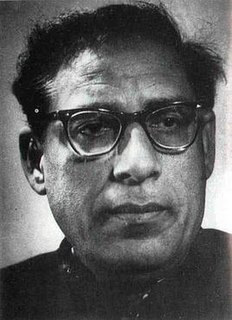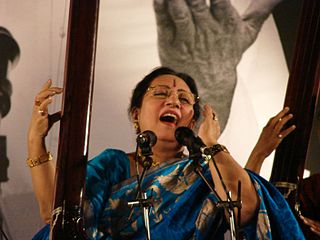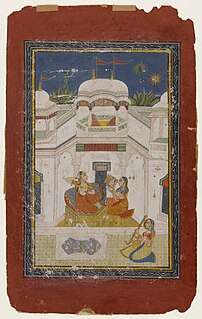Related Research Articles

Pandit Jasraj was an Indian classical vocalist, belonging to the Mewati gharana. His musical career spanned 75 years resulting in national and international fame, respect and numerous major awards and accolades. His legacy includes memorable performances of classical and semi-classical vocal music, classical and devotional music, albums and film soundtracks, innovations in various genres including Haveli Sangeeth and popularizing the Mewati Gharana - a school of thought in Hindustani classical music. Pandit Jasraj taught music to amateur and professional students in India, Europe, Canada and the United States.

Ustad Amir Khan was one of the greatest and most influential Indian vocalists in the Hindustani classical tradition. He was the founder of the Indore gharana.

Ashwini Bhide-Deshpande is a Hindustani classical music vocalist from Mumbai. She belongs to the Jaipur-Atrauli gharana tradition.
"Malhar" is a Hindustani classical raga. Malhar is associated with torrential rains.

Begum Parveen Sultana is an Indian Hindustani classical singer of the Patiala Gharana. She was awarded the Padma Bhushan by the Government of India in 2014 and the Sangeet Natak Akademi Award by the Sangeet Natak Akademi in 1998.

Bilaval or Bilawal is a raga and the basis for the eponymous thaat in Hindustani classical music. Raga Bilaval is named after Veraval, Gujarat.
Originally, Baiju Bawara- a famous classical singer, was born at a village/town called “Bajwara” in District- Hoshiarpur, Punjab. He defeated Tan Sen- the shahi court singer of Emperor Akbar. All other stories about his history are manipulated myths. He was fully devoted to his classical singing and people use to call him Bawaraa
Bahar is a Hindustani classical raga. This raga is very similar to raga Malhar. This raga is from the Kafi Thaat.
Brindavani Sarang or Brindabani Sarang, also known as raga Sarang, is a Hindustani classical raga. It is also called Vridavani Sarang. This raga falls under the category of Sarang ragas.
Megh Malhar is a Hindustani classical raga. The name derives from the Sanskrit word Megh, meaning cloud. Legends say that this raga has the power to bring out rains in the area where it is sung. Megh Malhar is similar to raga Megh with a tint of Malhar in it.
Megh is a Hindustani classical raga. The meaning of Megh in Sanskrit is 'Cloud'. Hence this raga is mostly sung or played in the Monsoon season. Another raga which describes rain is raga Malhar. So these 2 ragas where merged and a new raga was developed, this raga is raga Megh Malhar. The Carnatic equivalent of this raga is Madhyamavati.
Miyan ki Todi, often simply referred to as Todi or Darbari Todi, is a Hindustani classical raga which gave its name to the Todi thaat, one of the ten types of classical music according to the musicologist Bhatkhande. Ragas from the Todi raganga include Todi itself, Bilaskhani Todi, Gujari Todi, Desi Todi, Hussaini Todi, Asavari Todi, and Bahaduri Todi.

Madhyamavati (madhyamāvati) is a rāga in Carnatic music. It is an audava rāga, as it does not have all the seven musical notes (swaras). It is a janya rāga. The equivalent of Madhyamavati in Hindustani music is Madhumad Sarang. It also has other equivalents in Hindustani music such as ragas Megh and Megh Malhar.

Raga Kedar, also known as Kedara, is a Hindustani classical raga. Named after Lord Shiva, the raga occupies a high pedestal in Indian classical music. It is characterised by many melodious turns. This raga is the repetition of the swaras सा and म. It is generally accepted that it displays much thermal energy and is regarded as the Raagini of Raag Deepak. While preceding from Shuddha Madhyam (m) to Pancham (P), a touch of Gandhar (G) or a smooth passage from Gandhar (G) to Pancham (P) expressed as m G P is the more common way of instant raga manifestation.
Durga is a raga in Hindustani Classical music. It shares some features with Shuddha Saveri of Carnatic music, but is significantly different from it in terms of the sancharas of the raga.
Kalyan is one of the ten basic thaats of Hindustani music from the Indian subcontinent. It is also the name of a raga within this thaat.
Kafi is one of the ten basic thaats of Hindustani music from the Indian subcontinent. It is also the name of a raga (Kharaharapriya) within this thaat.
Gaud Sarang is a raga in Hindustani classical music that combines characteristics of Sarang and the now extinct raga named Gaud. Unlike most other members of the Sarang family of ragas, Gaud Sarang is assigned to the Kalyan thaat rather than the usual Kafi.

Sarang ragangHindustani pronunciation: [ˈsärəŋg ˈrägäŋg], and all other ragas falling under this category are ragas in the Hindustani Classical music. Ragang refers to a family of ragas, sharing a common melodic kernel. Other similar raga families are the Malhar family and the Kanada family. The Sarang ragas are sung in the time period of early afternoon. This includes many ragas originating from folk music and songs. The Sarang raga and all other ragas falling under in this type depict the scenes of the Indian historic past events, e.g. Raag Brindabani Sarang depicting Vrindavan or Lankādahan Sārang depicting Hanuman singing this raga while burning Lanka with his tail, etc.
References
- 1 2 3 4 5 Bor, Joep; Rao, Suvarnalata (1999). The Raga Guide: A Survey of 74 Hindustani Ragas. Nimbus Records with Rotterdam Conservatory of Music. p. 68. ISBN 9780954397609.
- ↑ "On Gaud Malhar and Miyan Malhar". Rajan Parrikar Music Archive. Retrieved 31 August 2018.